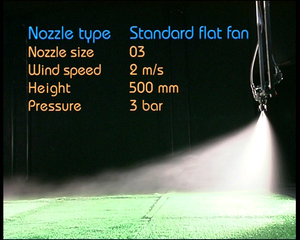A couple of blogs ago I discussed some of the issues around aquatic buffer zones. I promised to mention spray application in a future blog. Well, the future starts here.
One issue that spray specialists keep banging on about is boom height. Lifting the boom so that nozzle tips are 20 cm above the typical recommended height of 50 cm can double spray drift. Why is spray drift so sensitive to boom height?
Drift from all types of nozzles can be minimised by ensuring that the tips of the nozzles are as low as possible above the target to provide good spray coverage. This is 50 cm for 110 degree nozzles at a half metre spacing. In addition, spray pressures should not be above around 3 bar for conventional flat fan nozzles.
Data produced from experiments in the wind tunnel of the Silsoe Spray Application Unit emphasise the considerable influence on spray drift of the height of the tip of the nozzle. Increasing it by 20 cm (8 inches) can double the drift from a conventional standard flat fan nozzle and the increase from extended range/variable pressure flat fan nozzles is even greater. These latter nozzles produce higher levels of drift than conventional flat fan nozzles when operating at 3 bar.

The question frequently posed is why such a small increase in the height of the tip of the nozzle can increase drift risk so dramatically? The answer is clearly demonstrated in the photograph taken at the Silsoe Spray Application Unit. This shows that drift largely emanates from a zone a distance below the nozzle.
The actual distances involved will depend on many variables, such as nozzle type and size, wind speed, forward speed and spray pressure. However, in simple terms, where the tips of the nozzles are 50 cm above the target and the zone where most of the drift originates is 20 cm above the target, then increasing the height of tip of the nozzle by 20 cm can more than double the size of this zone.
There is a simple explanation as to why drift largely emanates from spray fan nozzles at a distance from the tip of the nozzle: the spray liquid leaves the nozzle under pressure and at a high velocity and entrains (draws in) air as it travels.
The influences of both spray pressure and air entrainment fade as the spray droplets move away from the flat fan nozzle and eventually the droplets fall solely by gravity if the boom is far too high. By the time they get to just above the target, the droplets are moving slower and are the most vulnerable to drift. Smaller droplets lose their momentum more quickly and so not only is the ‘driftable zone’ wider for fine quality sprays from flat fan nozzles but also the smaller droplets are more ‘driftable’.
There are calls for CRD to adopt four star nozzles in order that aquatic buffer strips can be reduced in width. The current three star nozzles reduce drift by 75% compared to a standard 11003 nozzle working at 3 bar pressure. Some ‘smaller droplet’ air induction nozzles meet this target but often at slow forward speeds and pressures which may mean some compromises in efficacy. Even when working at 3 bar they have a few issues with efficacy e.g. small weeds with foliage applied herbicides and, anecdotally, on potato blight. One way of reducing spray drift by 90% or even 95% is to use even coarser nozzles but this will result in further compromises with efficacy because of poor spray retention on leaves and/or spray distribution, particularly on small targets and even, perhaps, on the soil surface.
There are ways in which such drift reduction is possible and which largely or completely retain efficacy but it may require a radical overhaul of the vast majority of sprayers currently on farms. Air assistance is one option. With conventional boom sprayers, achieving a 90% drift reduction and the good and uniform spray distribution necessary for some targets may mean a reduction in boom height. Some sprayer manufacturers now offer 25 cm nozzle spacings as an option aimed at drift control with the recommendation that the boom is operated 25 cm above the target. Boom suspension then needs to be very good with effective height sensors and probably some articulation.
There is a long way to go on the issue of aquatic buffer zones and spray application. This topic deserves to be higher up on the agenda of the future of farming in the UK.
